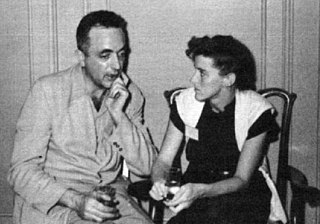"To Arkham and the Stars" is a short story by American writer Fritz Leiber, belonging to the Cthulhu Mythos genre of horror fiction. It was written for the 1966 Arkham House anthology The Dark Brotherhood and Other Pieces . Set in H. P. Lovecraft's Arkham and Miskatonic University, it includes characters from and allusions to several Lovecraft stories.

Fritz Reuter Leiber Jr. was an American writer of fantasy, horror, and science fiction. He was also a poet, actor in theater and films, playwright and chess expert. With writers such as Robert E. Howard and Michael Moorcock, Leiber can be regarded as one of the fathers of sword and sorcery fantasy, having coined the term.

The Cthulhu Mythos is a shared fictional universe, originating in the works of American horror writer H. P. Lovecraft. The term was coined by August Derleth, a contemporary correspondent and protégé of Lovecraft, to identify the settings, tropes, and lore that were employed by Lovecraft and his literary successors. The name Cthulhu derives from the central creature in Lovecraft's seminal short story, "The Call of Cthulhu", first published in the pulp magazine Weird Tales in 1928.
Arkham House is an American publishing house specializing in weird fiction. It was founded in Sauk City, Wisconsin in 1939 by August Derleth and Donald Wandrei to preserve in hardcover the best fiction of H. P. Lovecraft. The company's name is derived from Lovecraft's fictional New England city, Arkham. Arkham House editions are noted for the quality of their printing and binding. The colophon for Arkham House was designed by Frank Utpatel.
Contents
Robert M. Price, who included the story in his 1992 anthology Tales of the Lovecraft Mythos, said it "has proven to be a seminal Mythos tale, as in it we first see the depiction of Miskatonic University as having, as it were, a Mythos Studies Department." Price traces the influence of Leiber's story on such works as Philip José Farmer's "The Freshman", Lin Carter's "Zoth-Ommog" and Brian Lumley's The Burrowers Beneath and The Transition of Titus Crow. [1]

Robert McNair Price is an American New Testament scholar who argues against the existence of a historical Jesus. He taught theology and religious studies at the Johnnie Colemon Theological Seminary. He is a professor of biblical criticism at the Center for Inquiry Institute, and the author of a number of books on biblical studies and the historicity of Jesus.
Philip José Farmer was an American author known for his science fiction and fantasy novels and short stories.

Linwood Vrooman Carter was an American author of science fiction and fantasy, as well as an editor, poet and critic. He usually wrote as Lin Carter; known pseudonyms include H. P. Lowcraft and Grail Undwin. He is best known for his work in the 1970s as editor of the Ballantine Adult Fantasy series, which introduced readers to many overlooked classics of the fantasy genre.









